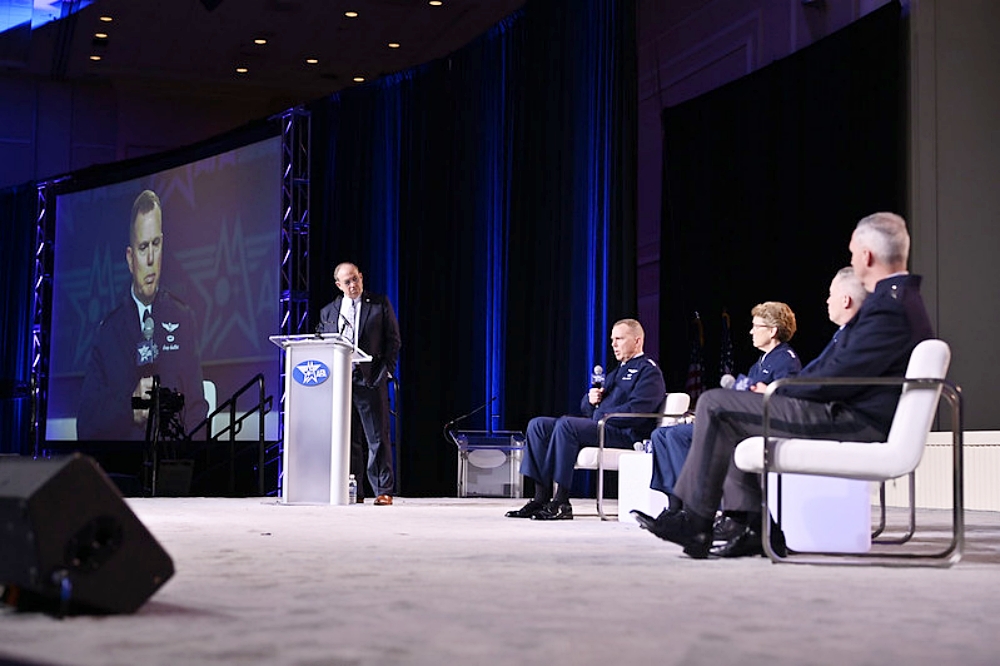Russian aircraft have encroached on the Alaska air defense indication zone (ADIZ) four times in the last week, the head of NORAD and U.S. Northern Command noted Sept. 17, as he said he wants to ramp up his command’s training and monitoring capabilities.
“We’ve had four straight nights of intercepting Russian aircraft that have penetrated inside the Alaska ADIZ,” Air Force Gen. Gregory M. Guillot said at AFA’s Air, Space & Cyber Conference. “NORAD fighters, AWACS (Airborne early warning and control aircraft), and tankers intercepted them all, everything safely and professionally. But it shows an increased presence.”
The steady stream of incursions included:
- Two Russian military aircraft on Sept. 11
- Two TU-142 bombers on Sept. 13
- Two IL-38 patrol aircraft on Sept. 14
- Two IL-38 patrol aircraft on Sept. 15
NORAD posted on social media that it scrambled U.S. fighters to intercept the aircraft on Sept. 11 but didn’t specify the type of the Air Force jets or the Russian aircraft involved that day.
Incursions into the air defense identification zone are not the same as entering U.S. or Canadian airspace. Russian activity in this buffer zone occurs regularly and NORAD is “accustomed” to the activity, it says. But the frequency is notable—it’s the most consecutive days with an announced detection in years.
It also builds on another notable incident in July, when NORAD tracked two Chinese Xian H-6s and two Russian Tu-95s, escorted by Russian fighter jets, flying near Alaska, the first appearance of Beijing’s bombers in a combined patrol through the area.
“It was just coordinated, not integrated like how two NORAD countries … are very well integrated,” Guillot noted.

Air Force Gen. Gregory M. Guillot, commander of NORAD and U.S. Northern command, speaks at the AFA’s Air, Space & Cyber Conference on Sept. 17
While not yet a display of interoperability, the incident marked the eighth coordinated bomber flight between Beijing and Moscow since 2019, reflecting a growing level of cooperation.
“China spends a lot more time up there,” Guillot cautioned. “It shows, on a daily basis, that the Arctic is an area where a number of nations are showing interest, not only for military purposes, but also for scientific purposes.”
Since branding itself a “near-Arctic State” in 2018, China has showed increased interest in the Arctic for economic and strategic reasons. Although not a major Arctic player yet, experts noted that Beijing views melting ice caps as a gateway to new trade routes, and it may seek to leverage Russia’s Arctic activities to bolster its own presence in the region.
“We are pursuing sensors that go from sea floor all the way up to space in multiple layers and domains, to make sure that we can detect all of those adversaries,” said Guillot, highlighting that this capability must surpass the ranges covered five or 10 years ago and needs to reach “much further away,” given the advanced capability of adversaries’ weapons.
Specifically for better monitoring aircraft, cruise missiles and hypersonic weapons, Guillot’s predecessor, Gen. Glen VanHerck successfully championed new over-the-horizon radar (OTHR) capabilities. However, in June, the Air Force told lawmakers that it would no longer fund the program in fiscal 2024 as planned, postponing the decision to 2026.
In order to get continuous surveillance, Guillot said he is now eyeing unmanned aerial vehicles as an interim solution. U.S. Central Command is also eyeing low-cost, long-endurance drones through the Air Force’s Task Force 99 program.
“As we look to see which capabilities can be fielded, first, having a gap filler, such as a high-altitude, long-endurance UAVs, could help us utilize the platform’s flexibility and agility to go where we need in that vast landscape,” said Guillot. “I’m very intrigued by what Gen. Kurilla and CENTCOM are doing in the UAV realm. Of course, they need a different sensor suite than we do, so we’ll have to make sure that the type of payloads we need will work. … But I certainly think it’s something that we could look at.”
While UAVs such as RQ-4 Global Hawk drones could offer more flexibility and broad coverage of the area, Guillot added that their sensors and payloads will likely have to be tailored for Arctic conditions to ensure smooth operation without compromising endurance or altitude.
It’s not just the aircraft that have to be prepped for the Arctic. Guillot also hinted at a plan to boost Arctic training—toughening up warfighters for the harsh cold and rugged terrain.
“We’re also trying to increase the number and complexity of exercises that we conduct up there,” said Guillot. “Our fighter squadrons… they’re not necessarily used to working in that environment, and that’s something that takes specific training and, in cases, specific equipment.”
Top Photo: Air Force Gen. Gregory M. Guillot, commander of NORAD and U.S. Northern command, speaks at the AFA’s Air, Space & Cyber Conference on Sept. 17.
Source: Air & Space Forces Magazine

